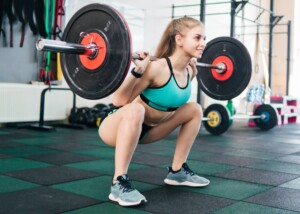
Anyone who’s struggled to get parallel in the squat (femur torso ratio) knows that elevating the heels makes this possible, and here’s why.
For those with long femurs and short torso who can’t achieve a parallel squat without leaning over like in a “good morning” position, elevating the heels (even a little bit) makes getting parallel possible.
If you’ve elevated your heels to get into a parallel squat (due to torso shorter than femur), perhaps you’ve also noticed that it seems as though more tension is on the knees and middle muscle of the thigh. You are not imagining this.
Why does elevating the heels make it possible to parallel squat in those with long femurs and short torsos?
In order to keep balance and prevent falling backwards while descending towards parallel, you must keep the shoulder aligned vertically with the midfoot.
One way to get the shoulder over the midfoot is to lean the torso forward.
Long femurs force the hips out further when lowering into a parallel squat, which means that the torso has more distance to lean forward to get the shoulders over the midfoot.

Those with long torsos don’t have as far to go as those with short torsos, assuming that relative femur length is identical for both people.
Sometimes the femurs are the bigger culprits, in that they are much longer than the shin bones.
The other way to get the shoulder aligned with the midfoot is to shift the knees forward while keeping the feet flat on the floor.
Shifting the knees forward will, in turn, shift the shoulders forward, while the feet stay fixed in one spot on the ground.
Your knees will shift forward (keeping heels on floor) only as far as the flexibility in your heel/foot will allow (a joint action called dorsiflexion).
If you go up on the balls of your feet, which elevates your heel, you can squat parallel and even all the way down while keeping a straight back.
- The elevated heel rotates the position of the feet forward, or “tips” them forward.
- This tipping automatically pushes the knees out more.
- Your shoulder is now easily aligned over your midfoot without having to lean the torso forward.
HOWEVER, you’ll also notice that when squatting on the balls of your feet, which produces a considerable ankle elevation, the knees may feel strained.
Squat all the way down (like a baseball catcher), then stand all the way up — on the balls of your feet. Feel that in the knees? And do you feel it in the middle quad muscle?
This is because the knees were way ahead of the feet, which is a poor way to perform a barbell or even goblet squat.
Now, imagine placing the heels on a one-inch-high board, a few small weight plates to elevate them, or elevating the heels by wearing a heeled shoe.
You can now more comfortably squat parallel despite the long femurs and short torso.
Again, the elevation “tips” the foot forward, which automatically drives the knees out further in front.
This forward shift causes the shoulders to forward shift, bringing them in alignment with the midfoot.
Unfortunately, as just pointed out, this forward shift puts more tension on the knees and subtracts tension from the glutes and hamstrings.
Nevertheless, the slight heel elevation is a sensible option for those with long femurs and a short torso who struggle to parallel squat.
 Lorra Garrick is a former personal trainer certified through the American Council on Exercise. At Bally Total Fitness she trained women and men of all ages for fat loss, muscle building, fitness and improved health.
Lorra Garrick is a former personal trainer certified through the American Council on Exercise. At Bally Total Fitness she trained women and men of all ages for fat loss, muscle building, fitness and improved health.













